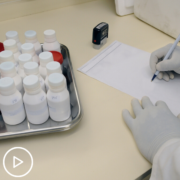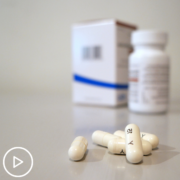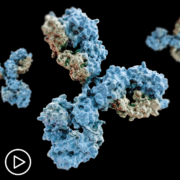Myeloma Treatment Options: What’s Available?
Myeloma Treatment Options: What’s Available? from Patient Empowerment Network on Vimeo.
Renowned myeloma researcher, Dr. Irene Ghobrial, provides an overview of current treatment options for myeloma, including an explanation of the now commonly used four-drug regimen.
Dr. Irene Ghobrial is Director of the Clinical Investigator Research Program at Dana-Farber Cancer Institute and Professor of Medicine at Harvard Medical School. Dr. Ghobrial specializes in multiple myeloma (MM) and Waldenström macroglobulinemia (WM), focusing on the precursor conditions of monoclonal gammopathy of undetermined significance (MGUS) and smoldering myeloma. More about this expert here.
See More From Fact of Fiction? Myeloma
Related Resources

|

|
Transcript:
Patricia:
Let’s get an overview of available myeloma treatments.
Dr. Ghobrial:
Oh, boy. Okay, how long do we have here? It depends. The moment I see a patient – and again, maybe we can start with smoldering myeloma because that’s an area I’m really excited about.
If you have asymptomatic disease, it does not mean you have to watch and wait until you fall apart, until you have bone lesions, until you have anemia. We want to see those patients early because we have a lot of clinical trials, and potentially, the cure may actually be in an earlier precursor session when we treat you earlier before you have the disease.
But, the standard of care is when you have symptoms – anemia, hypercalcemia, lytic lesions, and renal failure, or other things like 60% plasma cells – we say you have active multiple myeloma, and in that case, we start saying, “Well, are you a transplant candidate or not?” In the old days, it used to be by age, but now, we say age is just a number, so it really depends on if you have good organ function, are you in an active good state, do you have good lungs, good heart, are you willing to take the transplant, because now, there’s a big discussion whether we should transplant patients or not.
And then, at the end of the day, we’re starting to actually blur that, saying that most of our treatments are almost identical, whether you are old or young, whether you’re a transplant candidate or not. It depends on frailty. Can you tolerate this treatment or not? Maybe a few years ago, we used to say a three-drug regimen is the best way to go.
Now, most of us are starting to say four-drug regimen up front is the way to go, which is an antibody – currently, it’s daratumumab – a proteasome inhibitor – it could be bortezomib or carfilzomib – an immunomodulator – likely, this is lenalidomide – and then, dexamethasone. That’s sort of the option that we have right now, at least in the U.S.
If you go to Europe, you’ll find us using different drugs, like thalidomide or other things, but most of us are thinking of a four-drug regimen to think of our up-front myeloma treatment to get you the best remission, eventually MRD-negative disease, and then we talk about transplant or no transplant, and then, of course, we talk about maintenance.
We want to keep everyone on maintenance therapy; the question is how long, which maintenance, do we use one drug or not? So, there is a lot to be discussed in treatment of myeloma, and that’s the beauty of it. It’s truly an art and science together. It’s not just “Here’s a combination because you have this treatment.” We really personalize therapy for you.
We look at your cytogenetics, your FISH. We say you have high-risk cytogenetics or not, you’re young or not, you have good organ function or not.
There are so many things that we put in consideration when we come up with a treatment plan for a patient.








![[ACT]IVATED Myeloma Resource Guide for Veterans and First Responders](https://powerfulpatients.org/wp-content/uploads/ACTIVATED-Myeloma-Resource-Guide-for-Veterans-and-First-Responders-180x180.png)


